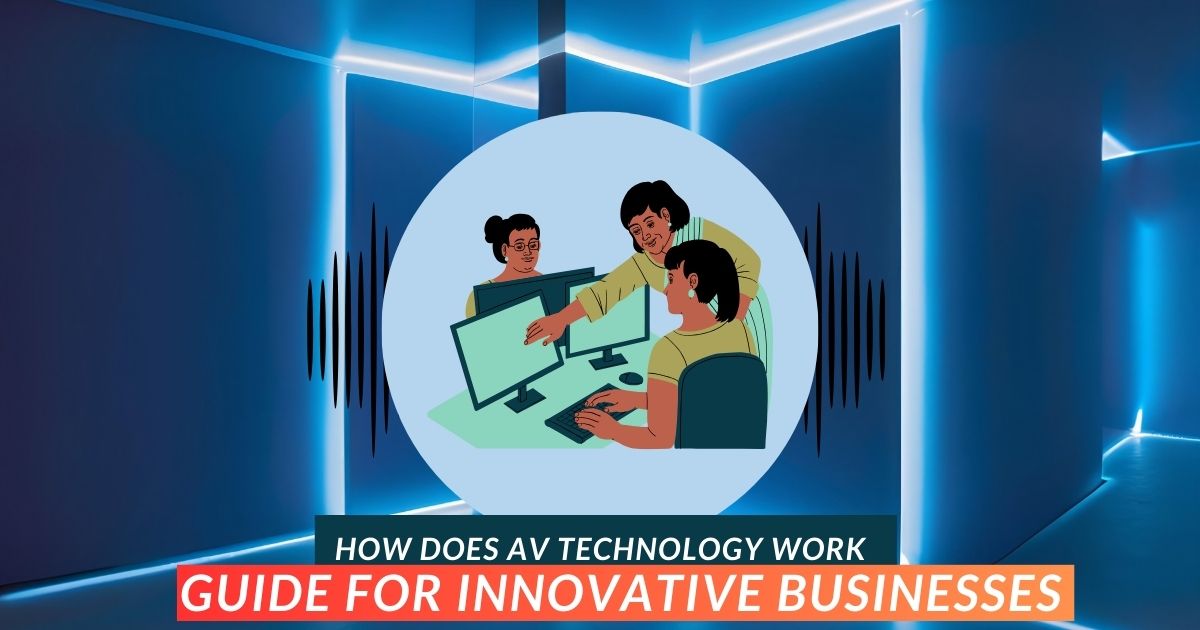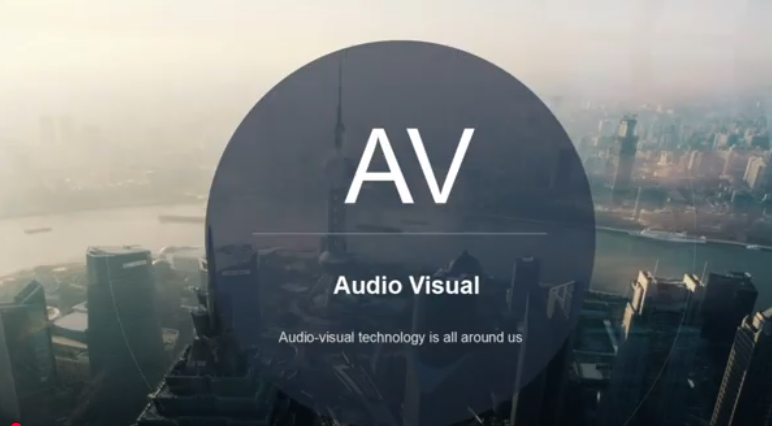How Does AV Technology Work: A Guide for Innovative Businesses

Audio-Visual (AV) technology refers to systems and tools that use sound and visual components to deliver information or create engaging experiences.
This technology plays a vital role in our daily lives, powering everything from home entertainment systems and virtual classrooms to business presentations and conference rooms.
Whether watching a movie, attending an online lecture, or collaborating in a remote meeting, AV technology enhances communication and makes interactions more immersive and effective.
Audiovisual technology helps businesses embrace the future. A firm that innovates is one that will stand the test of time. You’ll also be able to stay ahead of your competitors, many of whom won’t know current AV trends.
What is Audiovisual Technology?
Audiovisual systems are any that use audio and/or visual components to create a spectacular or practical experience. Though many of these combine audio and visual technology, there is often a greater focus on visuals. However, you can’t neglect the audio side.

AV technology is a very broad term. It describes an incredible range of tools, including hardware and software solutions.
Here are just some examples of AV tech:
- Video walls (and their paired controller devices)
- Microphones
- Digital signage
- Spatial audio
- Matrix switchers
- Amplifiers
- Interactive whiteboards
- Sound masking
- Virtual reality
- Sound beaming
- Video conferencing software
Any one of these tools could help your staff or customers in some way.
For more insights on how AV technology can drive business growth and success, check out our related blog post: [Achieving Business Success With Integrated AV Solutions]
What are the Components of AV Technology
Audio Components
Audio components are the parts of AV systems responsible for capturing and delivering sound. They include the following:
- Microphones
Microphones are devices that capture sound by converting sound waves into electrical signals. They are used in various settings, like recording music, conducting meetings, or live performances. Different types of microphones are suited for different purposes, such as handheld, lapel, and condenser microphones.
- Speakers
Speakers take the electrical signals from microphones or other audio sources and turn them back into sound waves that people can hear. They are important for broadcasting sound in classrooms, theaters, or outdoor events. High-quality speakers improve sound clarity and make it easier for audiences to understand the message or enjoy the music.
- Amplifiers
Amplifiers are used to increase the strength of an audio signal so that it can be heard clearly through the speakers. Without amplifiers, the sound would be too weak to reach large audiences. These are essential for events like concerts or public speeches.
- Sound Processors
Sound processors modify or enhance audio signals. For example, they can reduce background noise, add special effects, or balance sound levels. These are commonly used in music production, broadcasting, and live events to improve sound quality.
- How Sound is Captured, Transmitted, and Amplified
First, microphones capture sound waves and change them into electrical signals. Then, these signals may pass through sound processors to enhance quality. Amplifiers make the signal stronger, and finally, the processed sound is sent to speakers, where it is converted back to audible sound for the audience.
Visual Components
Visual components are those used to display and project images, videos, or graphics. These include:
- Displays such as Projectors, LED Panels, and Screens
Projectors display images or videos onto large surfaces like walls or screens using a beam of light. They are commonly used in classrooms, theaters, and business meetings. LED panels are screens made of small light-emitting diodes (LEDs) and are known for their bright and sharp visuals. These are often used for digital advertising or big events like concerts. Screens are the surfaces where images or videos are shown, ranging from small TV screens to huge cinema screens.
- Cameras and Video Production Equipment
Cameras capture video or images for live streaming, recording, or broadcasting. They are used in studios, theaters, and even online meetings. Video production equipment includes tools like tripods, lighting, and video editing software to create high-quality visual content. These tools make everything from movies to YouTube videos look more professional.
Control Systems
Control systems are used to manage and operate all the AV equipment easily and efficiently.
- Centralized Systems for Managing AV Equipment
A centralized control system allows users to control multiple AV devices from one place, like a tablet or a touch panel. For example, in a conference room, you can use a centralized system to adjust microphones, speakers, and projectors without needing to operate each device separately.
- Software and Hardware Integration
Control systems often combine both software and hardware. The hardware includes remote controls or physical panels, while the software allows you to automate tasks, like scheduling a projector to turn on at a specific time. This integration makes AV systems user-friendly and efficient.
These components work together to create advanced audio-visual experiences for education, entertainment, and business.
Going Global Through AV Tools
Video conferencing is a highly popular form of AV technology, especially in recent years. During the COVID-19 pandemic, Zoom (and similar apps) allowed many teams to keep working.
Many companies still use video conferencing and collaboration solutions even after returning to in-person work. Depending on your industry, you could hire remote workers through Zoom.
How Different Industries Innovate Using AV Technology?
Every sector uses AV solutions in different ways. AV is now nearly inseparable from modern business practices.
With this in mind, here are eight sectors using audiovisual tech in new and innovative ways:
- Retail: Many stores now use AV-driven self-service kiosks. Some also use augmented or virtual reality apps to guide buyers through products and the store’s layout.
- Education: Video conferencing has made “blended learning” an option for many college courses. It’s now easier than ever to learn from the comfort of the home.
- Healthcare: Some surgeons use VR to practice complex procedures. They’ll have a full understanding of what they must do, without any unnecessary risk to the patient.
- Events: Projection mapping and spatial sound make events more immersive. You’ll have the tools to create large-scale live events that astound everyone who attends.
- Manufacturing: AR makes it easier to visualize a product at every stage. With the right tools, such as IoT sensors, your team could also spot defects more easily.
- Security: An HD, or even 4K, video wall will give your security officers greater situational awareness. A screen processor lets them seamlessly switch between feeds.
- Hospitality: Sound masking adds white noise to a space to make conversations harder to overhear. Your restaurant’s guests will be able to unwind and talk privately.
- Government: Digital signage makes it easier to convey messages to the public. You can set these up in populated areas to give real-time updates as and when necessary.
Making the Most of Your Displays
Many companies use AV tech in the form of screens. If you use a computer, laptop, or phone in your business, you’re relying on audiovisual solutions.
Large-scale video walls let you deliver more powerful presentations. You’ll be able to amaze bigger crowds and make sure the information remains crystal-clear. Video walls today can easily show up to 4K (possibly even 8K) content.
A video wall relies on special controllers that synchronize a feed across multiple screens without lag. With modern processors, all it takes is a few clicks to scale and switch these displays.
You can also invest in a matrix switcher. These devices make routing input signals to outputs far easier.
Future Prospects
Innovations like augmented reality (AR) and virtual reality (VR)
Augmented Reality (AR) and Virtual Reality (VR) are emerging as pivotal channels for digital transformation in industrialization, fostering innovation and entrepreneurship. These technologies are reshaping industries by enabling immersive experiences and creating opportunities for new business models and solutions.
AR enhances real-world environments with interactive digital overlays, while VR creates entirely immersive digital worlds, revolutionizing training, collaboration, and product development across various sectors.
Their integration into industries is not only driving efficiency but also empowering entrepreneurs to innovate and scale their ventures, paving the way for a more digitally interconnected future.
For more detailed information on these innovations, their applications, and the opportunities they create, please explore the accompanying PDF document.
Role of Artificial Intelligence (AI) in Transforming AV Experiences
The Role of Artificial Intelligence (AI) in Transforming AV Experiences. Here is the research of all about this topic on avixa.
Final Thoughts
Virtually every piece of audiovisual technology works differently. In addition, how you integrate it into your company depends on your industry. You must also carefully audit your business to see which solutions fit it best.
Sound and visual components are seamlessly combined by AV technology to produce dynamic, complete experiences that attract and involve audiences. Its crucial significance in modern innovation is highlighted by its capacity to improve commercial processes, entertainment, and communication.
This technology’s importance in creating a more connected and interactive future continues to grow as it develops further, opening up fresh possibilities for efficiency and creativity.
FAQs
What is AV technology?
AV (Audio-Visual) technology combines audio and visual components to create immersive experiences used in many applications such as conferences, entertainment, education, and more.
How does AI impact AV technology?
Artificial Intelligence increases AV systems by introducing features like advanced data analytics, real-time adjustments, and personalized user experiences. This innovation improves efficiency, adaptability, and overall system effectiveness.
What industries benefit the most from AV advancements?
Industries like entertainment, education, healthcare, retail, and corporate sectors significantly benefit from AV advancements, leveraging the technology for communication, training, and customer engagement.
What are some emerging trends in AV technology?
Emerging trends include AR/VR integration, AI-driven automation, higher quality displays (such as 8K), and advanced audio systems that provide more immersive and seamless user experiences.
How will the future of AV technology shape communication?
The future of AV technology is expected to facilitate more perceptive and interactive communication, bridging gaps through virtual collaboration tools, telepresence systems, and smarter, AI-enabled platforms.






